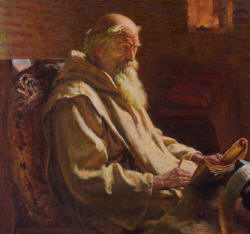
The Explanation Of The Apocalypse
PREFACE
THE Explanation of the Apocalypse by Ven. Beda is the earliest of the many works of our own writers on that Book, and, as such, may well deserve to appear in a form accessible to English readers. But independently of this, it is a commentary of much value and interest in itself, as is shewn by the constant use of it by Isaac Williams in his volume on the Apocalypse (The Apocalypse, with Notes and Reflections, Lond. 1852), and the notices of it in two recently-published Lectures of the Bishop of Lincoln (On the Millennium, Lond. 1875), who also, in his “Introduction to the Book of Revelation,” terms it, “A valuable and interesting exposition” (Greek Testament, Gen. Ep. and Rev., p. 152, 1872).
The chief characteristics of Beda’s method of exposition may be thus stated. The several visions are considered not to be successive, but contemporaneous, with occasional recapitulations, and to represent the condition of the Church in all ages, under different aspects. The thousand years, in the twentieth chapter, are interpreted of the present period of the Church’s existence, in accordance with the opinion of St. Augustine, in the second part of his De Civitate Dei. The attention is closely directed to the text, and to corresponding passages of Holy Scripture, that the meaning of the symbolic language may be elicited. The previous exposition of Tichonius is mainly, but not exclusively followed. Beda appears, for example, to have adopted several opinions from St. Gregory the Great, and Primasius, as well as St. Augustine.
The date of the “Explanation” is circ. A.D. 710–716. It is described by Beda as an “Exposition” (see note p. 1). But it is called an “Explanation” in the printed editions of his works.
The translation is made from the edition of the Works of Beda by Dr. Giles, Lond. 1844, vol. xii., which, in this part at least, is merely a reprint of the earlier text. The notes are limited to the references required by the text, and the occasional notice of various readings, with some illustrations from other writers. Some additional notes will be found at the end.
For the sake of conciseness, the text, as read by Beda, which is not given completely even in the editions of the original Latin, where there frequently occurs the sign of omission, has not been translated in full. But the Commentary itself, by the addition of the usual numbering of the verses, and the insertion of catchwords in Clarendon type, has been rendered available for use with the original Greek, or with any translation. These words, though not necessarily so, are yet, by far the most frequently, from the Authorised Version. Care has been taken that the version may be as literal an one as is consistent with a proper rendering into English.
It may be stated, on information derived through the favour of Mr. E. A. Bond, that the MS. of the thirteenth century in the British Museum, No. 223 of the Harleian Collection, containing a Commentary on the Apocalypse, ascribed in the colophon to Beda, is a different work from that printed in Dr. Giles’ edition.

 Support Site Improvements
Support Site Improvements